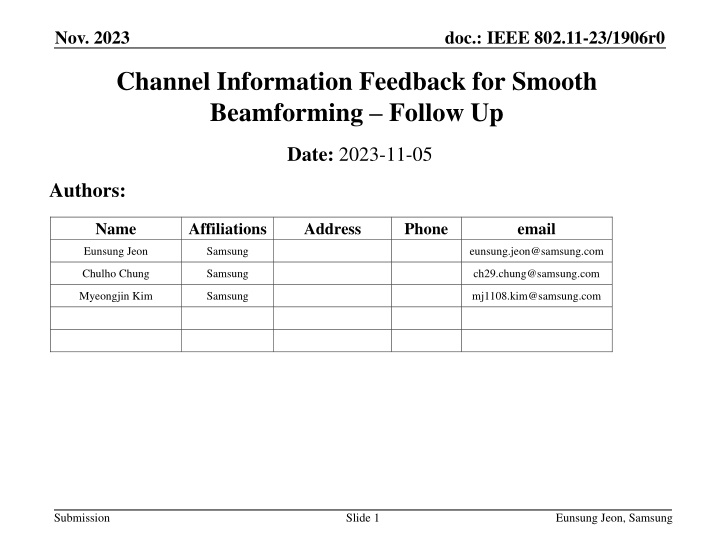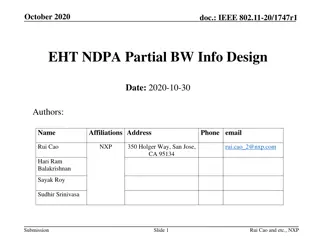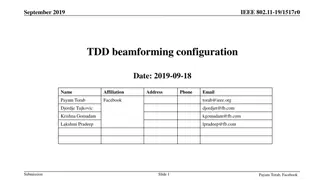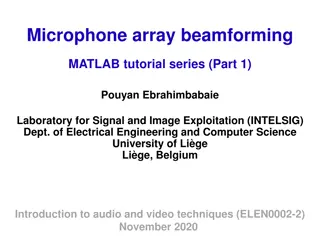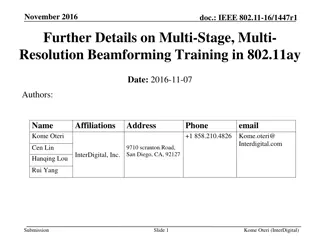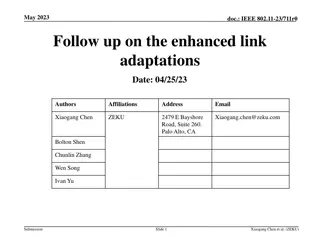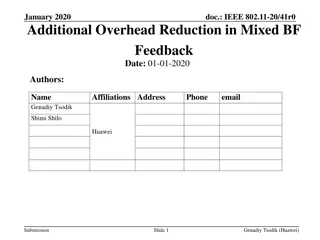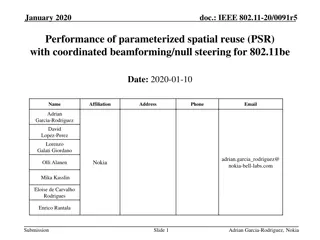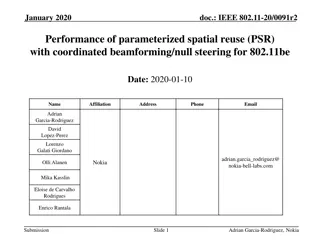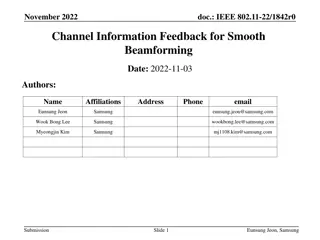Channel Information Feedback Enhancement for Improved Beamforming Performance
Beamforming plays a crucial role in achieving high throughput in wireless networks, but issues with discontinuity in beamforming lead to performance limitations. This document discusses the challenges with current beamforming practices and proposes a solution by increasing feedback overhead to enhance channel smoothing and maximize throughput gain. By optimizing the beamforming process for smoother operations, significant improvements in performance can be achieved without compromising transmission quality.
Download Presentation

Please find below an Image/Link to download the presentation.
The content on the website is provided AS IS for your information and personal use only. It may not be sold, licensed, or shared on other websites without obtaining consent from the author.If you encounter any issues during the download, it is possible that the publisher has removed the file from their server.
You are allowed to download the files provided on this website for personal or commercial use, subject to the condition that they are used lawfully. All files are the property of their respective owners.
The content on the website is provided AS IS for your information and personal use only. It may not be sold, licensed, or shared on other websites without obtaining consent from the author.
E N D
Presentation Transcript
Nov. 2023 doc.: IEEE 802.11-23/1906r0 Channel Information Feedback for Smooth Beamforming Follow Up Date: 2023-11-05 Authors: Name Affiliations Address Phone email Eunsung Jeon Samsung eunsung.jeon@samsung.com Chulho Chung Samsung ch29.chung@samsung.com Myeongjin Kim Samsung mj1108.kim@samsung.com Submission Slide 1 Eunsung Jeon, Samsung
Nov. 2023 doc.: IEEE 802.11-23/1906r0 Introduction (1/2) Beamforming can be a key solution that can achieve one of the goals of UHR [1]. Increase throughput including at different SNR levels (at least 25%). However, the throughput of beamforming has been limited due to discontinuity issue of the beam-steering matrix. This makes it difficult to achieve the channel smoothing gain (1~3dB). This also makes it difficult to estimate the channel using 2x-LTF. The 2x-LTF is a widely used LTF type in the commercial WLANs, which requires interpolation for channel estimation. However, discontinuous (beamformed) channel cannot be estimated with simple linear interpolation. Error floor is inevitable in high QAM (e.g., 4096-QAM), resulting in max throughput degradation. The reason for the discontinuity is that the current standard of compressed beamforming feedback is optimized to minimize the size of the compressed beamforming report (CBR). Submission Slide 2 Eunsung Jeon, Samsung
Nov. 2023 doc.: IEEE 802.11-23/1906r0 Introduction (2/2) However, a slight increase in feedback overhead can solve the discontinuity problem, leading to significant throughput gain [2]. This maximizes the smoothness of the beam-steering matrix. Through this, more channel smoothing gain can be obtained for the beamforming signal. Since actual channel conditions in local area networks are semi- static, the sounding process occurs sparsely compared to frequent transmission of beamforming signals. E.g., One sounding process per 100ms. A slight increase (or decrease) of the feedback overhead has a negligible effect on throughput performance. Following [3], this contribution shows additional feedback of channel information is very effective way to increase throughput. Submission Slide 3 Eunsung Jeon, Samsung
Nov. 2023 doc.: IEEE 802.11-23/1906r0 Sounding & Beamforming Process Proposed: Conventinal: Optimzed to minimize the size of CBR Optimized to maximize the smoothness of beamforming data ... ... Beamforming Data Beamforming Data NDPA NDP NDPA NDP SIFS SIFS SIFS SIFS Beamformer Compressed Beamforming Report Compressed Beamforming Report Beamformee Sounding Proces Sounding Process Sounding Interval Submission Slide 4 Eunsung Jeon, Samsung
Nov. 2023 doc.: IEEE 802.11-23/1906r0 Background Theorem There are infinitely many unitary matrices for a given channel H, i.e., H =??? = ????? where ??= ??? and ??= diag ???1,?,???2,?, ,????,?, ??,? [0,2?) Proof: See [4]. For backward compatibility, we propose to use D and ? as both options. D: The column-wise phase matrix to minimize the feedback overhead. ? : The column-wise phase matrix to maximize the smoothness. = ????? = Proposed: Optimal in terms of maximizing the smoothness Conventional: Optimal in terms of minimizing the feedback overhead Submission Slide 5 Eunsung Jeon, Samsung
Nov. 2023 doc.: IEEE 802.11-23/1906r0 Proposed Smooth Beamforming Feedback Conventional Proposed (Step 1) SVD(H) = U?Vh H: channel estimates ?12???12 ?22???22, ?: diagonal matrix with singular value. (Step 2) Column-wise phase shift - Multiply a diagonal matrix ? . - The elements in the last row become a complex number. - Optimal in terms of maximizing the smoothness. ?11???11 ?21???21 U, V: unitary matrix, E.g.? = - Multiply a diagonal matrix ?. - The elements in the last row become a real number. - Optimal in terms of minimizing the feedback overhead. ? = ?? ? = ?? ) ) ?11??(?11+?1 ?21??(?21+?1 ?12??(?12+?2 ?22??(?22+?2 ?12??(?12 ?22) ?22 ?11??(?11 ?21) ?21 = = ) ) where ? = ? ??21 where ? = ???1 0 0 ? ??22 0 ???2 0 (Step 3) Compression of Q using Givens rotation Submission Slide 6 Eunsung Jeon, Samsung
Nov. 2023 doc.: IEEE 802.11-23/1906r0 How to Design ? (1/3) In case of Nrx = 1, ? = ? Since channel vector (H) is frequency-correlated, V is a smooth beamforming matrix. Propose to use ? = 1. No computation cost required. 1??(?1 ?3) 2??(?2 ?3) 3 Conventional D = ? ??3 ? = ?? = 1???1 2???2 3???3 1???1 2???2 3???3 ? = ? = 1???1 2???2 3???3 Proposed ? = 1 ? = ?? = Submission Slide 7 Eunsung Jeon, Samsung
Nov. 2023 doc.: IEEE 802.11-23/1906r0 How to Design ? (2/3) In case of Nrx > 1, Many solutions can be considered [5], [6], [7]. As an example, we can use ? as below. ,???2 , ,????? = diag ???1 ?? (??[?]) ?? 1? (??[?]) ?? 1?, ? = 1,2, ,?? ??[?] is the i-th column of V V for the k-th subcarrier. ??[?] is the i-th column of Q Q for the (k-1)-th subcarrier. = ???? This is optimal in terms of maximizing the cross-correlation of two adjacent Q. = arg max ? This is also optimal in terms of minimizing the Euclidean distance of two adjacent Q. = arg min ? Xcor ?? 1,??? , where Xcor(A, B) Re{Tr(A ?)} ?? ?? ?? 1 ???? Submission Slide 8 Eunsung Jeon, Samsung
Nov. 2023 doc.: IEEE 802.11-23/1906r0 How to Design ? (3/3) Sequential processing For Nc > 1, the optimization of Q is performed sequentially from the beginning to the end of the subcarriers. For Nc= 1, the optimization process is bypassed. (i.e., ??=??) Submission Slide 9 Eunsung Jeon, Samsung
Nov. 2023 doc.: IEEE 802.11-23/1906r0 Feedback Overhead (1/2) The number of angles is increased by ??. ??numer of ????, (? = 1,2, ,??) is newly added in the Compressed Beamforming Feedback Matrix subfield. E.g., Red marked angles in the table below. E.g., May be carried in a new Smooth Beamforming Report subfield Due to the limited form factor, ?? value is generally less than 2 in the current mobile devices. (i.e., using 1 or 2 receive antennas) Order Information Size of V Number of angles Angles in the Compressed Beamforming Feedback Matrix subfield 1 Category 2 Action 11, 21, 31, 41, 51, 61, 71, 81, 21, 31, 41, 51, 61, 71, 81 3 MIMO Control 14 15 8 1 Compressed Beamforming Report 4 11, 21, 31, 41, 51, 61, 71, 81, 22, 32, 42, 52, 62, 72, 82, 21, 31, 41, 51, 61, 71, 81, 32, 42, 52, 62, 72, 82 MU Exclusive Beamforming Report 5 26 28 8 2 6 CQI Report 7 Smooth Beamforming Report Submission Slide 10 Eunsung Jeon, Samsung
Nov. 2023 doc.: IEEE 802.11-23/1906r0 Feedback Overhead (2/2) As the number of transmit antennas (i.e., the size of V) increases, the increase rate of feedback overhead decreases. For MU-MIMO, which has larger feedback overhead, the increase rate is smaller. We can use the proposed scheme adaptively according to the size of V. Size of V (?? ??) Feedback Type Conventional (Byte) Proposed (Byte) Increase Rate (%) 1572 1947 23.8 4 2 9 SU 4072 4447 8 2 5 9072 9447 16 2 2759 3322 20 4 2 8 MU 6759 7322 8 2 4 9322 9697 16 2 Submission Slide 11 Eunsung Jeon, Samsung
Nov. 2023 doc.: IEEE 802.11-23/1906r0 Cross-correlation Comparison By feeding back additional phase information, cross-correlation between two adjacent beam-steering matrices is significantly improved. [Snap-shot] [Histogram] Submission Slide 12 Eunsung Jeon, Samsung
Nov. 2023 doc.: IEEE 802.11-23/1906r0 Performance Comparison (1/2) MU-MIMO, 8x2, 2 user, 4096-QAM, 2x EHT-LTF PER More than 2dB gain thanks to the application of the channel smoothing. Throughput Throughput is calcalcuated with considering feedback overhead Data payload / (Time for NDPA, NDP, BFRP, SIFS, CBR and Data) * (1-PER) / BW About 30% increase in max throughput Can satisfy the target of UHR project (25% increase in throughput) Submission Slide 13 Eunsung Jeon, Samsung
Nov. 2023 doc.: IEEE 802.11-23/1906r0 Performance Comparison (2/2) Some beamformer may have smoothing capability (Smooth TxBF). If the proposed scheme is used jointly with Smooth TxBF, more PER perf ormance gain can be obtained. SU-MIMO, 4x2, 2ss, 4096-QAM, 2x ETH-LTF Around 0.5dB gain can be obtained. Submission Slide 14 Eunsung Jeon, Samsung
Nov. 2023 doc.: IEEE 802.11-23/1906r0 Summary We discussed the improvement of beamforming which can achieve a target of UHR. Proposed to feedback additional phase information to obtain more channel smooth gain for the beamforming signal. Considering that sounding occurs very sparsely, a slight increase in overhead has a very small effect on throughput loss, but throughput gain of the smooth beamforming is significant. If beamformer does not have smoothing capability, The proposed scheme can be used as a stand-alone solution that provides a smooth beam-steering matrix to the beamformer. If beamformer has smoothing capability, By using the proposed scheme, additional performance gains can be obtained. Submission Slide 15 Eunsung Jeon, Samsung
Nov. 2023 doc.: IEEE 802.11-23/1906r0 Reference [1] 802.11-22/1392r0, Beamforming Improvement for UHR, Samsung. [2] 802.11-22/1820r1, BF Feedback with the Optimal SVD, Zeku. [3] 802.11-22/1842r0, Channel Information Feedback for Smooth Beamforming, Samsung. [4] E. Sengul, H. J. Park and E. Ayanoglu, Bit-Interleaved Coded Multiple Beamforming with Imperfect CSIT, IEEE Trans. Commun, vol. 57, no. 5, May 2009. [5] E. Jeon, M. Ahn, S. Kim, W. B. Lee and J. Kim, "Joint Beamformer and Beamformee Design for Channel Smoothing in WLAN Systems," in Proc. IEEE 92nd Veh. Technol. Conf. (VTC2020-Fall), Nov. 2020. [6] Y. Qui, D. Qu, Da Chen and T. Jiang, Smoothed SVD-based Beamforming for FBMC/OQAM Systems Based on Frequency Spreading, in Proc. IEEE Global Communications Conference (GLOBECOM), Dec. 2016. [7] J. S. Sadowsky, T. Yamaura and J. Ketchem, WWiSE Preambles and MIMO Beamforming, IEEE, Tech. Rep. 802.11-05/1635r1, Jan. 2005. Submission Slide 16 Eunsung Jeon, Samsung
Nov. 2023 doc.: IEEE 802.11-23/1906r0 SP Do you support to feed back additional phase information to improve the smoothness of the beam-steering matrix? Y/N/A Submission Slide 17 Eunsung Jeon, Samsung
